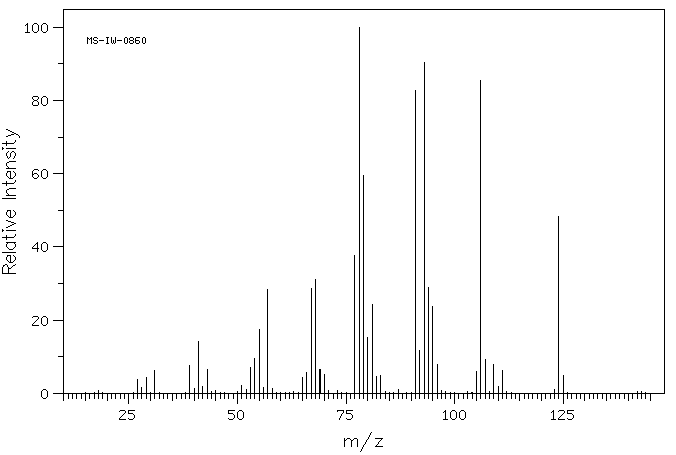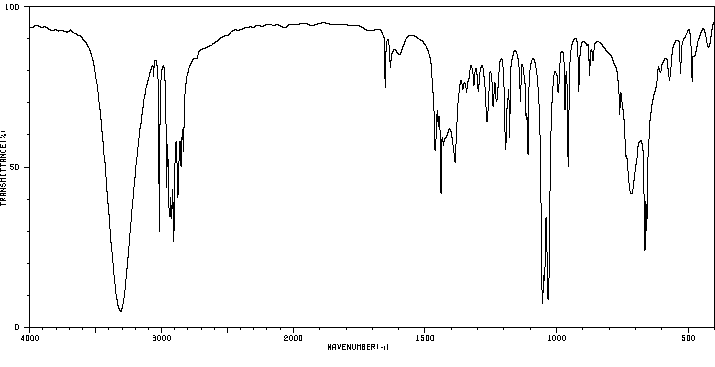3-环己基-1,1-二甲醇 | 2160-94-3
物质功能分类
中文名称
3-环己基-1,1-二甲醇
中文别名
环己烯-1,1-二甲基醇;3-环己烯-1,1-二甲醇
英文名称
4,4-bis(hydroxylmethyl)cyclohexene
英文别名
4,4-bis-hydroxymethyl-cyclohexene;1,1-bis(hydroxymethyl)-cyclohex-3-ene;3-Cyclohexene-1,1-dimethanol;[1-(hydroxymethyl)cyclohex-3-en-1-yl]methanol
CAS
2160-94-3
化学式
C8H14O2
mdl
MFCD00001575
分子量
142.198
InChiKey
YXEBFFWTZWGHEY-UHFFFAOYSA-N
BEILSTEIN
——
EINECS
——
-
物化性质
-
计算性质
-
ADMET
-
安全信息
-
SDS
-
制备方法与用途
-
上下游信息
-
文献信息
-
表征谱图
-
同类化合物
-
相关功能分类
-
相关结构分类
物化性质
-
熔点:88-90 °C(lit.)
-
沸点:115 °C (0.4 mmHg)
-
密度:1.0037 (rough estimate)
-
稳定性/保质期:
在常温常压下保持稳定,应避免与不相容的材料及强氧化剂接触。
计算性质
-
辛醇/水分配系数(LogP):0.5
-
重原子数:10
-
可旋转键数:2
-
环数:1.0
-
sp3杂化的碳原子比例:0.75
-
拓扑面积:40.5
-
氢给体数:2
-
氢受体数:2
安全信息
-
危险品标志:Xn
-
安全说明:S24/25,S36
-
危险类别码:R22
-
WGK Germany:3
-
海关编码:2906199090
-
储存条件:密封储存,应存放在阴凉干燥的库房中。
SDS
| Name: | 3-Cyclohexene-1 1-dimethanol 98% Material Safety Data Sheet |
| Synonym: | 4,4-Bis(hydroxymethyl)-1-cyclohexene; 1,1-bis(Hydroxymethyl)-3-cyclohexene; 4,4-bis(Hydroxymethyl)cyclohexen |
| CAS: | 2160-94-3 |
Synonym:4,4-Bis(hydroxymethyl)-1-cyclohexene; 1,1-bis(Hydroxymethyl)-3-cyclohexene; 4,4-bis(Hydroxymethyl)cyclohexen
Section 2 - COMPOSITION, INFORMATION ON INGREDIENTS
| CAS# | Chemical Name | content | EINECS# |
| 2160-94-3 | 3-Cyclohexene-1,1-dimethanol | 98.0 | 218-481-2 |
Risk Phrases: 20/21
Section 3 - HAZARDS IDENTIFICATION
EMERGENCY OVERVIEW
Harmful by inhalation and in contact with skin.
Potential Health Effects
Eye:
May cause eye irritation.
Skin:
May be harmful if absorbed through the skin.
Ingestion:
May be harmful if swallowed.
Inhalation:
May cause respiratory tract irritation.
Chronic:
No information found.
Section 4 - FIRST AID MEASURES
Eyes: Flush eyes with plenty of water for at least 15 minutes, occasionally lifting the upper and lower eyelids. Get medical aid immediately.
Skin:
Get medical aid. Flush skin with plenty of water for at least 15 minutes while removing contaminated clothing and shoes. Wash clothing before reuse.
Ingestion:
If victim is conscious and alert, give 2-4 cupfuls of milk or water.
Never give anything by mouth to an unconscious person. Get medical aid immediately.
Inhalation:
Remove from exposure and move to fresh air immediately. If not breathing, give artificial respiration. If breathing is difficult, give oxygen. Get medical aid.
Notes to Physician:
Antidote: None reported.
Section 5 - FIRE FIGHTING MEASURES
General Information:
As in any fire, wear a self-contained breathing apparatus in pressure-demand, MSHA/NIOSH (approved or equivalent), and full protective gear. During a fire, irritating and highly toxic gases may be generated by thermal decomposition or combustion.
Extinguishing Media:
Use water spray, dry chemical, carbon dioxide, or appropriate foam.
Section 6 - ACCIDENTAL RELEASE MEASURES
General Information: Use proper personal protective equipment as indicated in Section 8.
Spills/Leaks:
Clean up spills immediately, observing precautions in the Protective Equipment section. Sweep up, then place into a suitable container for disposal. Avoid generating dusty conditions. Provide ventilation.
Section 7 - HANDLING and STORAGE
Handling:
Wash thoroughly after handling. Remove contaminated clothing and wash before reuse. Use with adequate ventilation. Minimize dust generation and accumulation. Avoid contact with eyes, skin, and clothing. Avoid ingestion and inhalation.
Storage:
Keep container closed when not in use. Store in a cool, dry, well-ventilated area away from incompatible substances.
Section 8 - EXPOSURE CONTROLS, PERSONAL PROTECTION
Engineering Controls:
Facilities storing or utilizing this material should be equipped with an eyewash facility and a safety shower. Use adequate ventilation to keep airborne concentrations low.
Exposure Limits CAS# 2160-94-3: Personal Protective Equipment Eyes: Wear appropriate protective eyeglasses or chemical safety goggles as described by OSHA's eye and face protection regulations in 29 CFR 1910.133 or European Standard EN166.
Skin:
Wear appropriate gloves to prevent skin exposure.
Clothing:
Wear appropriate clothing to prevent skin exposure.
Respirators:
Follow the OSHA respirator regulations found in 29 CFR 1910.134 or European Standard EN 149. Use a NIOSH/MSHA or European Standard EN 149 approved respirator if exposure limits are exceeded or if irritation or other symptoms are experienced.
Section 9 - PHYSICAL AND CHEMICAL PROPERTIES
Physical State: Crystalline powder
Color: White - Beige Crystalline Powder
Odor: None reported.
pH: Not available.
Vapor Pressure: Not available.
Viscosity: Not available.
Boiling Point: Not available.
Freezing/Melting Point: 88.00 - 90.00 deg C
Autoignition Temperature: Not available.
Flash Point: Not available.
Explosion Limits, lower: N/A
Explosion Limits, upper: N/A
Decomposition Temperature:
Solubility in water:
Specific Gravity/Density:
Molecular Formula: C8H14O2
Molecular Weight: 142.20
Section 10 - STABILITY AND REACTIVITY
Chemical Stability:
Stable under normal temperatures and pressures.
Conditions to Avoid:
Incompatible materials, dust generation, strong oxidants.
Incompatibilities with Other Materials:
Strong oxidizing agents.
Hazardous Decomposition Products:
Carbon monoxide, carbon dioxide.
Hazardous Polymerization: Has not been reported.
Section 11 - TOXICOLOGICAL INFORMATION
RTECS#:
CAS# 2160-94-3: GW6050000 LD50/LC50:
CAS# 2160-94-3: Oral, mouse: LD50 = 1750 mg/kg; Oral, rabbit: LD50 = 3400 mg/kg; Oral, rat: LD50 = 1750 mg/kg.
Carcinogenicity:
3-Cyclohexene-1,1-dimethanol - Not listed by ACGIH, IARC, or NTP.
Other:
See actual entry in RTECS for complete information.
Section 12 - ECOLOGICAL INFORMATION
Section 13 - DISPOSAL CONSIDERATIONS
Dispose of in a manner consistent with federal, state, and local regulations.
Section 14 - TRANSPORT INFORMATION
IATA
Not regulated as a hazardous material.
IMO
Not regulated as a hazardous material.
RID/ADR
Not regulated as a hazardous material.
Section 15 - REGULATORY INFORMATION
European/International Regulations
European Labeling in Accordance with EC Directives
Hazard Symbols: XN
Risk Phrases:
R 20/21 Harmful by inhalation and in contact with
skin.
Safety Phrases:
S 24/25 Avoid contact with skin and eyes.
WGK (Water Danger/Protection)
CAS# 2160-94-3: No information available.
Canada
None of the chemicals in this product are listed on the DSL/NDSL list.
CAS# 2160-94-3 is not listed on Canada's Ingredient Disclosure List.
US FEDERAL
TSCA
CAS# 2160-94-3 is not listed on the TSCA inventory.
It is for research and development use only.
SECTION 16 - ADDITIONAL INFORMATION
N/A
上下游信息
-
下游产品
中文名称 英文名称 CAS号 化学式 分子量 —— 4,4-bis[(ethenyloxy)methyl]cyclohexene —— C12H18O2 194.274 —— 4,4-bis-(tert-butoxymethyl)-cyclohexene 819802-93-2 C16H30O2 254.413 —— 2,2-(2-Pentene-1,5-diyl)trimethylene carbonate 3592-10-7 C9H12O3 168.192 —— 8,10,19,20-tetraoxatrispiro[5.2.2.5.2.2]henicosa-2,14-diene —— C17H24O4 292.375
反应信息
-
作为反应物:描述:参考文献:名称:Shortridge et al., Journal of the American Chemical Society, 1948, vol. 70, p. 948摘要:DOI:
-
作为产物:描述:cyclohex-3-ene-1,1-dicarboxylic acid diethyl ester 在 lithium aluminium tetrahydride 作用下, 以 四氢呋喃 为溶剂, 反应 7.0h, 生成 3-环己基-1,1-二甲醇参考文献:名称:Synthesis of 4,4-Disubstituted 2-Aminocyclopentanecarboxylic Acid Derivatives and Their Incorporation into 12-Helical β-Peptides摘要:An enantioselective synthetic route is reported for trans-2-aminocyclopentanecarboxylic acids (ACPC) bearing geminal side chain pairs at the 4-position. beta-Peptides containing the 4,4-disubstituted ACPC residues adopt the 12-helical conformation, as demonstrated by 2D NMR analysis in aqueous solution. These 4,4-disubstituted ACPC residues display functional groups, including acidic and hydrogen bond donating groups, in a geometrically defined fashion, which should be useful for the design of beta-peptides for specific applications.DOI:10.1021/ol0483293
文献信息
-
Stereochemistry of cyclic compounds—I作者:Klaus Bruns、Jens Conrad、Alois SteigelDOI:10.1016/0040-4020(79)88015-1日期:1979.1the 3-methyl and 3-ethyl derivatives by fractional distillation. On the basis of 1H NMR spectroscopy, the nature of the isomerism is shown to be of cis, trans type and an unambiguous cofigurational assignment of the isomers has been achieved. Although the diastereomers are of similar topography, they have distinctly different olfactory properties.
-
A mild oxidizing reagent for alcohols and 1,2-diols: o-iodoxybenzoic acid (IBX) in DMSO作者:Marco Frigerio、Marco SantagostinoDOI:10.1016/0040-4039(94)80038-3日期:1994.10o-Iodoxybenzoic acid (IBX) smoothly oxidizes primary and secondary alcohols to aldehydes and ketones, respectively. 1,2-Diols are converted to α-ketols or α-diketones without any oxidative cleavage of the glycol CC bond. IBX oxidations are easily conducted in DMSO solution at room temperature, with yields ranging from good to quantitative.
-
Epoxidation by sodium chlorite with aldehyde-promoted chlorine dioxide formation作者:Ashok Jangam、David E. RichardsonDOI:10.1016/j.tetlet.2010.09.102日期:2010.12An improved method is described for selective room temperature epoxidation of alkenes by sodium chlorite in a solvent mixture of ethanol, acetonitrile, and water buffered at pH 7. In addition, the use of aldehydes as promoters in chlorite oxidations is described for the first time. The amount of sodium chlorite, the solvent mixture, and the addition of formaldehyde as a practical promoter were optimized
-
Substituted Pyrrolidine-2-Carboxamides申请人:Ding Qingjie公开号:US20100075948A1公开(公告)日:2010-03-25There are provided compounds of the formula wherein X, Y, R 1 , R 2 , R 3 , R 3 , R 4 , R 5 , R 6 and R 7 are as described herein and enantiomers and pharmaceutically acceptable salts and esters thereof. The compounds are useful as anticancer agents.提供了以下式的化合物 其中X、Y、R1、R2、R3、R3、R4、R5、R6和R7如本文所述,以及其对映体和药用可接受的盐和酯。这些化合物可用作抗癌药物。
-
Facile Synthesis of Aryl- and Alkyl-bis(trifluoromethylsulfonyl)methanes作者:Aiko Hasegawa、Takuo Ishikawa、Kazuaki Ishihara、Hisashi YamamotoDOI:10.1246/bcsj.78.1401日期:2005.8Various arylbis(trifluoromethylsulfonyl)methanes (1) have been synthesized by reacting the corresponding benzylic halides with sodium trifluoromethanesulfinate and then with triflic anhydride. In addition, when the aryl group of 1 is a pentafluorophenyl group, the nucleophilic para-substitution of the aryl group with alkyllithiums and sodium alkoxides occurs. This reaction is useful for the design of new Brønsted acids.
表征谱图
-
氢谱1HNMR
-
质谱MS
-
碳谱13CNMR
-
红外IR
-
拉曼Raman
-
峰位数据
-
峰位匹配
-
表征信息
同类化合物
(反式)-4-壬烯醛
(s)-2,3-二羟基丙酸甲酯
([1-(甲氧基甲基)-1H-1,2,4-三唑-5-基](苯基)甲酮)
(Z)-4-辛烯醛
(S)-氨基甲酸酯β-D-O-葡糖醛酸
(S)-3-(((2,2-二氟-1-羟基-7-(甲基磺酰基)-2,3-二氢-1H-茚满-4-基)氧基)-5-氟苄腈
(R)-氨基甲酸酯β-D-O-葡糖醛酸
(5,5-二甲基-2-(哌啶-2-基)环己烷-1,3-二酮)
(2,5-二氟苯基)-4-哌啶基-甲酮
龙胆苦苷
龙胆二糖甲乙酮氰醇(P)
龙胆二糖丙酮氰醇(P)
龙胆三糖
龙涎酮
齐罗硅酮
齐留通beta-D-葡糖苷酸
鼠李糖
黑芥子苷单钾盐
黑海棉酸钠盐
黑木金合欢素
黑曲霉三糖
黑介子苷
黄尿酸8-O-葡糖苷
麻西那霉素II
麦迪霉素
麦芽糖脎
麦芽糖基海藻糖
麦芽糖1-磷酸酯
麦芽糖
麦芽四糖醇
麦芽四糖
麦芽十糖
麦芽六糖
麦芽五糖水合物
麦芽五糖
麦芽五糖
麦芽五糖
麦芽三糖醇
麦芽三糖
麦芽三糖
麦芽三塘水合
麦芽七糖水合物
麦芽七糖
麦法朵
麦可酚酸-酰基-Β-D-葡糖苷酸
麦利查咪
麝香酮
鹤草酚
鸢尾酚酮 3-C-beta-D-吡喃葡萄糖苷
鸡矢藤苷










